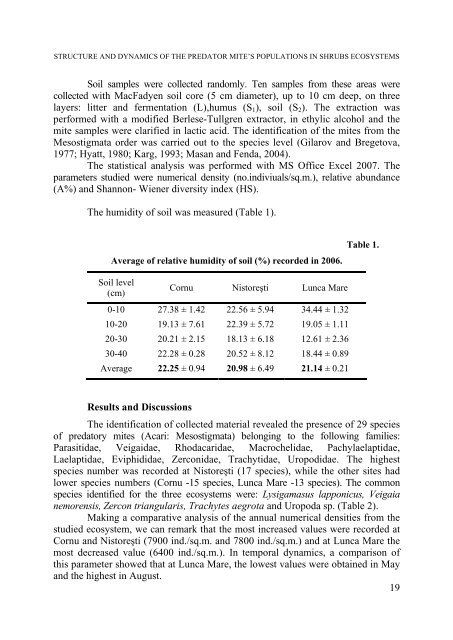biologia - Studia
biologia - Studia
biologia - Studia
You also want an ePaper? Increase the reach of your titles
YUMPU automatically turns print PDFs into web optimized ePapers that Google loves.
STRUCTURE AND DYNAMICS OF THE PREDATOR MITE’S POPULATIONS IN SHRUBS ECOSYSTEMS<br />
Soil samples were collected randomly. Ten samples from these areas were<br />
collected with MacFadyen soil core (5 cm diameter), up to 10 cm deep, on three<br />
layers: litter and fermentation (L),humus (S 1 ), soil (S 2 ). The extraction was<br />
performed with a modified Berlese-Tullgren extractor, in ethylic alcohol and the<br />
mite samples were clarified in lactic acid. The identification of the mites from the<br />
Mesostigmata order was carried out to the species level (Gilarov and Bregetova,<br />
1977; Hyatt, 1980; Karg, 1993; Masan and Fenda, 2004).<br />
The statistical analysis was performed with MS Office Excel 2007. The<br />
parameters studied were numerical density (no.indiviuals/sq.m.), relative abundance<br />
(A%) and Shannon- Wiener diversity index (HS).<br />
The humidity of soil was measured (Table 1).<br />
Average of relative humidity of soil (%) recorded in 2006.<br />
Table 1.<br />
Soil level<br />
(cm)<br />
Cornu Nistoreşti Lunca Mare<br />
0-10 27.38 ± 1.42 22.56 ± 5.94 34.44 ± 1.32<br />
10-20 19.13 ± 7.61 22.39 ± 5.72 19.05 ± 1.11<br />
20-30 20.21 ± 2.15 18.13 ± 6.18 12.61 ± 2.36<br />
30-40 22.28 ± 0.28 20.52 ± 8.12 18.44 ± 0.89<br />
Average 22.25 ± 0.94 20.98 ± 6.49 21.14 ± 0.21<br />
Results and Discussions<br />
The identification of collected material revealed the presence of 29 species<br />
of predatory mites (Acari: Mesostigmata) belonging to the following families:<br />
Parasitidae, Veigaidae, Rhodacaridae, Macrochelidae, Pachylaelaptidae,<br />
Laelaptidae, Eviphididae, Zerconidae, Trachytidae, Uropodidae. The highest<br />
species number was recorded at Nistoreşti (17 species), while the other sites had<br />
lower species numbers (Cornu -15 species, Lunca Mare -13 species). The common<br />
species identified for the three ecosystems were: Lysigamasus lapponicus, Veigaia<br />
nemorensis, Zercon triangularis, Trachytes aegrota and Uropoda sp. (Table 2).<br />
Making a comparative analysis of the annual numerical densities from the<br />
studied ecosystem, we can remark that the most increased values were recorded at<br />
Cornu and Nistoreşti (7900 ind./sq.m. and 7800 ind./sq.m.) and at Lunca Mare the<br />
most decreased value (6400 ind./sq.m.). In temporal dynamics, a comparison of<br />
this parameter showed that at Lunca Mare, the lowest values were obtained in May<br />
and the highest in August.<br />
19
















